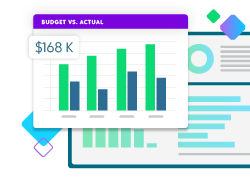How to Develop Your Nonprofit Operating Reserves

When you go out on a boat, you don’t expect a bumpy ride. But you wear a life jacket anyway.
When you work for a nonprofit organization, you don’t hope for a period of unexpected demand or income fluctuations. But you establish an operating reserve anyway.
Operating reserves provide a financial cushion to help nonprofit organizations weather economic uncertainty and make stronger strategic decisions. Every nonprofit organization should have one, but the amount and process for developing those reserves will vary for each organization. Factors such as cash flow cycles, revenue volatility, and spending flexibility make calculating operating reserves a personalized process for your nonprofit.
Still not sure if an operating reserve is right for your nonprofit? Check out this post for 5 Reasons Your Nonprofit Needs an Operating Reserve.
Find the Right Number for Your Nonprofit Operating Reserves
The Nonprofit Operating Reserves Initiative (NORI) Workgroup suggests that the minimum operating reserve ratio at the lowest point during the year should be 25 percent, or about three months of the annual operating expense budget. However, this is not a universal benchmark. It really does depend on the needs of your individual organization.
The Workgroup concluded that each organization must arrive at its own rationale for what it considers adequate for financial stability. There is no single correct solution–one size simply does not fit all when it comes to setting the amount for operating reserves.
The real takeaway here is to be able to articulate why the operating reserve fund exists for your organization and clearly understand the purpose, rather than getting hung up on the aggregate number. Being able to defend, explain, and educate your stakeholders why you’ve chosen a specific reserve amount is the key.
How To Calculate Your Operating Reserve Ratio
The Workgroup identified formulas for calculating the operating reserves ratio at the most basic level. When you use the formula for your organization, you may find that 25 percent is enough. Or it might not feel right for your organization. Here are three different ways to calculate the operating reserve ratio.
- Percentage Basis Formula: The reserves ratio is equal to your operating reserves divided by annual operating expense. The figure used for annual operating expenses can either be the prior year’s actual expenses or the current year’s budgeted expenses.
- Number-of-months Basis Formula: Here the reserves ratio is equal to your operating reserves divided by 1/12 of annual operating expense. For example, if your annual expense is $600,000, divide that amount by 12 to get $50,000. Then divide your current operating reserves balance (we’ll use $75,000 in this example) by $50,000. The result is 1.5—your organization would have one and half months of capital if needed.
- Setting the Target Formula: To set the target of your reserves to 25 percent, or 3 months, multiply your total annual expense by 0.25.
How Revenue Volatility Factors Affect Your Nonprofit’s Operating Reserves
In order to determine a target amount, you must consider the common factors at play in your operation. The extent that the following factors apply to your organization will help determine how large your reserve needs to be.
- Uneven cash flows: How much does your income and spending vary throughout the year?
- Revenue volatility factors: How volatile are your revenue sources?
- Spending flexibility factors: How much control do you have over your spending?
- Governance and Management factors: How does your Board feel about how much you should have in reserve vs spending on programs?
- Level of programmatic risk: Does your organization tend to take, or to encounter, programmatic risks?
- Organization life cycle stage: Is your organization young and scrappy or more established and settled?
The most significant of these factors are revenue volatility and spending flexibility.
Typical Revenue Volatility Factors
The level of revenue volatility your organization experiences can greatly affect the planning of your operating reserves. The more dependable and regular your funding is, the less risk you have and the lower your reserves can be. Key revenue volatility factors to consider:
- Stability of donated revenue from primary sources
- Predictability of pledge collections
- Reliability of grants and contracts for services
- Level of dependence on one or two major donors
- Level of dependence on a single fundraising event
- Funder policies on support of overhead, indirect expenses (operating vs. restricted/project-only support)
- Economic health of the community
- Publicity that could adversely affect current or future revenues
- Likelihood of severe weather or natural disasters that would affect your income, or your ability to perform income-producing programs
Typical Revenue Flexibility Factors
In some cases, spending may be dictated by external restrictions imposed on contributed funds. A reserve can provide the flexibility necessary to pay for items that aren’t covered by restricted grants. In general, the less control you have over your organization’s spending, the higher the risk and the higher your reserves might need to be.
Factors that may affect how much control you have on spending may include:
- Ability to downsize operations quickly and still sustain core programs
- Balance of full-time permanent staff versus part-time temporary staff or contractors
- Extent to which economic or environmental events may affect demand for services
- Long-term leases or vendor contracts with substantial penalties for cancellation
- Obligations to labor unions, union contracts
- Your organization’s importance in community crisis situations (e.g., if the organization’s mission involves disaster relief)
- Dependence on one key person
- Obligations resulting from your commitments to a donor’s purpose restrictions
- Amount of unsecured debt carried by the organization
Fund Accounting Software that Drives Impact
Find out how Blackbaud’s Financial Edge NXT® fits your organization.

Strategies for Budgeting and Raising Funds for Reserves
Once you know how much should be in your operating reserve, you can start setting funds aside for that purpose. There are several strategies your organization can use to budget and raise funds for your nonprofit’s operating reserve. The most successful method is to budget for operating surpluses annually. What the Nonprofit Finance Fund calls “consistent surpluses” is the best way to build reserve funds. Other potential strategies include:
- Include a “contribution to reserve” budget line item
- Fund non-cash depreciation expense with cash income
- Include in multi-year capital budgets
- Include as component of capital campaigns
- Include in planned giving campaigns
- Designate board contributions
- Designate staff vacancy savings
- Designate windfalls (one-time grants, gifts)
- Tariff (assign a percentage) of unrestricted gifts to build the reserve
Prepare Your Organization for What’s Next
By understanding the factors that affect your organization’s operations, you can create a financial cushion that will help you weather most changes without disrupting regular operations. If you have an issue where you have to dip into your operating reserves, make it a priority to refill that fund so you are prepared for the next unexpected bump in the road.
Operating reserves are a crucial part of a healthy financial statement, and there are several ways to calculate, hold, and manage those funds. Consult your auditor and CPA to identify the options that work best for your organization.
This post was originally published October 2016 and updated January 2025.

